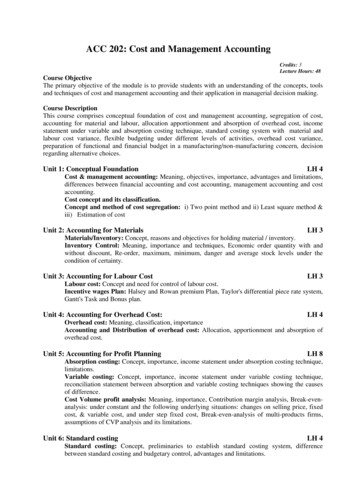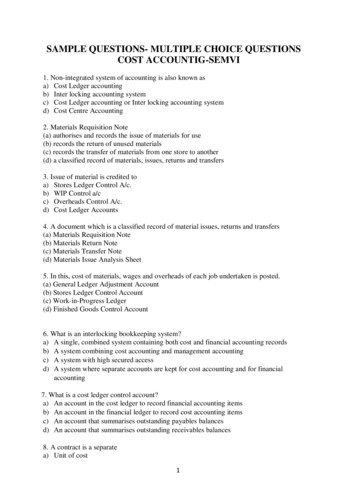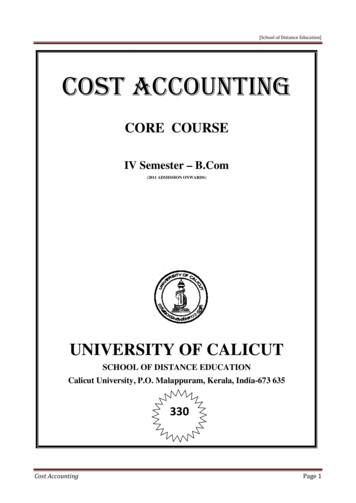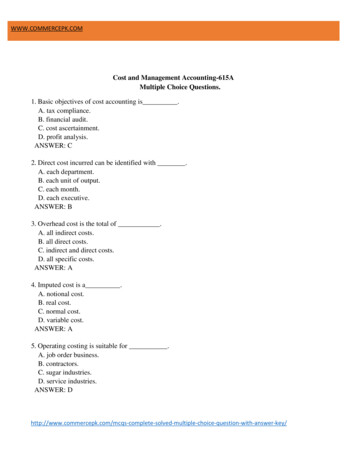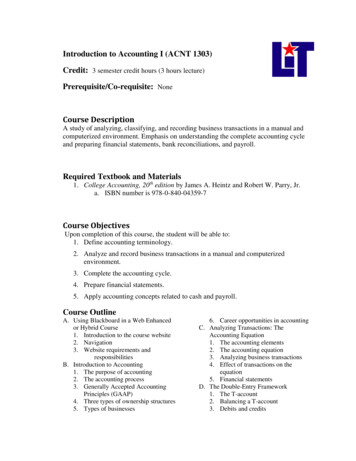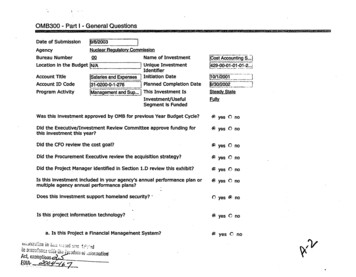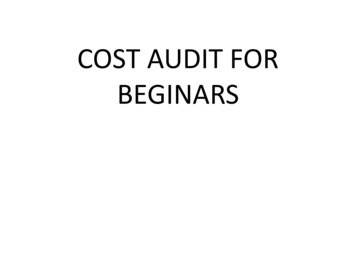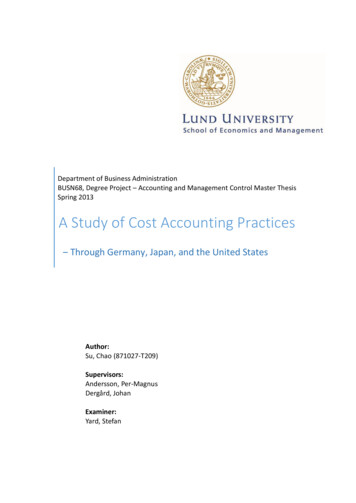
Transcription
Department of Business AdministrationBUSN68, Degree Project – Accounting and Management Control Master ThesisSpring 2013A Study of Cost Accounting Practices‒ Through Germany, Japan, and the United StatesAuthor:Su, Chao (871027-T209)Supervisors:Andersson, Per-MagnusDergård, JohanExaminer:Yard, Stefan
AbstractTitle: A Study of Cost Accounting Practices – Through Germany, Japan, and the UnitedStatesSeminar Date: 2013-05-29Course: BUSN68 Degree Project in Accounting and Management ControlAuthor: Chao SuSupervisors: Per Magnus Andersson & Johan DergårdKey-words: costing systems, development, cost accounting practices, national culturePurpose: this thesis aims to describe two most prominent cost accounting systemsoriginated in Germany, Japan, and the U.S. respectively from the background,theoretical and empirical aspects, thereafter through comparison amongst theexamined costing systems of the three chosen countries, bring about discussions oncost accounting practices in general as well as the development of cost accountingpractices in connection with the influence of national culture.MethodologyA qualitative research is performed for the purpose of this thesis. The case studystrategy is employed to focus on three cases, namely Germany, Japan, and the U.S. forin-depth observation for each case. Thereafter, to derive a discussion of costaccounting practices and national culture’s influences on the practices in general. Anindirect method is used to collect information on the three cases, where scholarlypublications are mostly relied on as source of information.Theoretical PerspectivesThree frameworks are presented to facilitate technical understanding of costingsystems and analysis of the systems’ characteristics. They are Bjornenak, T. & Olson,O.’s generic framework for unbundling cost accounting systems; Lall Niagam, BM. &Jain, IC.’s five classifications of total costs; and Fisher, JG. & Krumwiede, K.’s four majorcosting continuums.ConclusionsOne of the important results of the thesis is that it is difficult to draw lines betweencost accounting practices simply by terminology and the practices are constantlydeveloping in response to changes in the context. Further, national culture is observedto be a major determinant for the divergence of cost accounting practices in the threecountries.1
AcknowledgementThis paper is a grand finale of the Accounting and Management Control MasterProgramme I started in September 2012 at Lund University. It has been a preciousjourney for me where I have both widen and deepen my perspectives not onlyacademically, but also in my way of thinking and of seeing the world.I would like to give my sincere thanks to the Vice Dean Kristina Eneroth, programmedirector Per-Magnus Andersson, and programme coordinator Ingela Petersson fortheir kind communication with me to arrange a delayed submission of my thesis dueto an exceptional circumstance. I would also like to thank my supervisors Per-MagnusAndersson and Johan Dergård for their valuable advice, especially Per-Magus for histimely feedback via email even during the summer holiday. Gotthard Killian’s keensupport during the past four months is greatly appreciated.It feels like this journey has really come to an end as I am writing this. However, it willalways have a special place in my memory.Xiamen China, 2013-08-15Chao Su2
Table of contentsChapter I Introduction . 51.1 A retrospective . 51.2 Rational of cost accounting . 91.3 What is interesting? . 111.4 Purpose . 121.5 Outline. 12Chapter II Methodology . 142.1 The scope . 142.2 Method. 152.2.1 A qualitative research. 152.2.2. Source of information . 172.3 Limitations . 182.3.1 Inherent limitations . 182.3.2 Research limitations . 19Chapter III Framework for cost accounting system . 213.1 Bjornenak, T. & Olson, O. . 213.2 Lall Niagam, BM. & Jain, IC. . 243.3 Fisher, JG. & Krumwiede, K. 26Chapter IIII German’s path . 314.1Background . 314.2 Grenzplankostenrechnung (GPK). 334.2.1 Theoretical aspect . 334.2.2 Empirical aspect . 364.3 Relative Einzelkosten-und Deckungsbeitragsrechnung or Riebel’s generic direct costing 394.3.1 Theoretical aspect . 394.3.2 Empirical aspect . 41Chapter V Japan’s path . 435.1 Background . 435.2 Mehrstufige sortenkalkulation or lot costing . 455.2.1 Theoretical aspect . 455.2.2 Empirical aspect . 485.3 Genka kikaku or target costing . 495.3.1 Theoretical aspect . 495.3.2 Empirical aspect . 53Chapter VI U.S.’s path . 566.1 Background . 566.2 Standard costing. 586.2.1 Theoretical aspect . 586.2.2 Empirical aspect . 616.3 Activity-based costing (ABC) . 636.3.1 Theoretical aspect . 633
6.3.2 Empirical aspect . 66Chapter VII Analysis. 697.1 Characteristics of the six costing systems . 697.1.1 Bjornenak, T. & Olson, O. . 697.1.2 Lall Niagam, BM. & Jain, IC. . 707.1.3 Fisher, JG. & Krumwiede, K. 717.1.4 Discussion . 727.2 Influence of national culture . 747.2.1 Germany . 747.2.2 Japan . 777.2.3 U.S. . 797.2.4 Discussion . 82Chapter VIII Conclusion . 848.1 Reflection . 848.2 Suggestions for future research . 86References. 87Appendix . 100Appendix 1 . 100Appendix 2 . 102Appendix 3 . 102Appendix 4 . 1024
“Human beings learn through three ways – imitation, variation, and innovation.”(Killian, G., 2013)Chapter I Introduction1.1 A retrospectiveThe evolution of cost accounting as a single branch of knowledge can be roughlydivided into three eras – the first era from the first appearance until before theindustrialization; the second from the industrialization to the twentieth century; andthereafter the third (Antonelli, V. et al., 2009). It can be noticed that the three erasvery much coincide with the development of commerce, i.e. the mercantile, theindustrial, and the globalized, which is logical as the purpose of cost accounting is toserve the running of business hence it should reflect the major commercial activitiesof corresponding period.During the first era, the nomenclature cost accounting might not exist as a clear andwell-recognized concept like it is today, the activity could be called by other names, orcould be anonymous. The first faint appearance of cost accounting can be traced backto the fourteenth century (Thukaram Rao, ME., 2012; Roger, W. & Holzer, HP., 1990).Italian accounting historian Melis, 1950 argued in his most important book, Storia dellaragioneria (Accounting History), that specific accounting instruments wereunnecessary to a business so long as it remained in artisanal form. However, when itchanged into an organized capitalist form (e.g. the textile sector in the Italian context),new techniques were then needed to account for production costs. Thereby, thedevelopment of cost accounting is prompted by the rise of industrial enterprises in thefourteenth and fifteenth centuries. Early examples include the wool business ofFlorence Medici family keeping four books of entry in 1431: (1) a stock book forrecording purchases of wool and other materials; (2) a cash book; (3) a book of income5
and outflow; (4) a wage book (Kranowski, N., 1977). With the expansion of the scaleof business, mainly in manufacturing activities that small enterprises started toproduce trade items such as books, woolens, coins, and wine, an extension in costaccounting was required (Cunagin, C. & Stancil, JL., 1992). In England during the reignof Henry VII (1485-1509), many small workshop owners moved from cities to villagesso as to run away from the guilds which regulated the pricing of craftsmen’s products.Competition came along with this freedom to set prices, which marked the beginningof an intermediate system between the guilds and the factory and an emergingemphasis on cost control. Workers took raw material home then returned to theowner with finished products in exchange for payment. To control theft of material,owners had to estimate the amount needed for making a particular product, whichcould be regarded as a rudimentary form of variance analysis. Another example of anattempt to calculate product cost (or prix de revient in French) is the FrenchmanChristopher Plantin who operated a printing house in Flemish Antwerp in the mid1500’s, keeping separate books of all direct costs for each book edition printed,moreover, accounting for raw materials, work in process and finished goods in hisledger (Kranowski, N., 1977).The industrialization beginning in the late eighteenth century in England as theIndustrial Revolution and later spreading to other parts of the world, led tofundamental changes in agriculture, manufacture, transportation, economic policiesand the social structure (Montagna, JA., 1981). The changes in the macro-environmentgave rise to new developments in cost accounting as a result of the enormous impacton manufacturing methods and costs (Kranowski, N., 1977; Hume-Schwarz, JA., 2007).The only one work considering the issue of cost in an industrial setting published inItaly before the middle of the nineteenth century was by Moschetti (1610). Within thefinancial accounting system, Moschetti’s work touched upon certain accounts whichshould be debited specific (direct) costs, for the purpose of determining the profit orloss from the related manufacturing process. It is not until two centuries later, when6
industrialization began to make an earnest appearance, that an assortment of costaccounting literature in Italy was produced, e.g. by E. Mondini, E. Lai, A. De Brun, G.Massa, C. Montù, P. Avenati, A. Argenziano, and V. Gitti – G. Massa (Antonelli, V. et al.,2009). Quite a number of French writers have also published a collection of costaccounting literature in French by the end of the nineteenth century. The book Essaisur la tenue des Livres d’nue Manufacture in 1817 written by a Frenchman AnselmePayen, described a cost system of two sets of records – a journal and ledger “in money”for external transactions, also one “in kind” for raw materials, labor and other inputsfor production. By applying rent, depreciation and interest to product cost (prix derevient), he has made a step in the treatment of manufacturing overhead. Moreover,the internal movement of product costs from one segment to another in theproduction cycle was illustrated. Other major work include Godard, Maurice Jeannin,Adolphe Guilbault, F.N.Simon, M.E.Claperon, and Eugene Leautey. Then after theIndustrial Revolution, the English and Americans took over the lead in the field, notablywith respect of overhead apportionment and standard costing (Roger, W. & Holzer, HP.,1990; Kranowski, N., 1977). First the English and then the American engineers andaccountants became conscious of the ‘big picture’ and saw costs flowing through thesystem represented by the parts and products flowing through the conveyor belt.Building on the works of FW. Cronhelm, Charles Baggage, Henry Metcalfe, EmileGarcke and John Manger Fells; George P. Norton, J. Slater Lewis’s; Alexander HamiltonChurch; John Whitmore; Harrington Emerson; G. Charter Harrison; and Stanley Henrici,the application of overhead was substantially advanced and standard costing wasfirmly established. (Kranowski, N., 1977).The advancement of means of communication during the twentieth century greatlyenhances the possibility to export and re-import theory and practices (Parker, RH. &Yamey, BS., 1994), hence the voice from one original source is able to induce echo ona much larger scale, which is manifested by the growing debates in the research field.One well-known example is the controversial book Relevance Lost: The Rise and Fall of7
Management Accounting by H. Thomas Johnson and Robert S. Kaplan published in1987 (Lukka, K., 1993). Through an overview of the evolution of managementaccounting in American business, Johnson and Kaplan claimed that the developmentof management accounting has fallen short while innovations in accounting was takingplace mostly in financial accounting which is for preparing financial statementsimposed by the shareholders of the companies. The emphasis of cost accounting wasthus greatly placed on the construction of inventory cost for financial reporting. Theobsolescence of current cost accounting at that time resulted in myopic and ineffectualbusiness decisions by managers, hence called for new systems for that would assistmanagers with making decisions for the long-term interest of business. As a matter offact, academics such as Joel Dean and William Vatter in the 1950s had recognized theneed of managers to understand cost accounting for different purposes in theirpreliminary edition textbook Managerial Accounting. They pointed out that timelyinformation was essential for management and financial statements had a historicalperspective, thus recommended separation of cost accounting systems for internaland external users (Kaplan, RS., 1987). Influenced by Dean and Vatter, Charles T.Horngren, published another respected textbook Cost Accounting: A ManagerialEmphasis in 1962, with an objective to present how the most important role ofaccounting was as a management tool for better decision-making (Graduate school ofStandard business, 2011). Nevertheless, these pioneering attempts did not appear topermeate the practices of businesses, and have only reached other academics in thefield (Kaplan, 1984). Moreover, Kaplan, RS. (1984) claimed that cost accountingresearch was mostly referring to economists and lacked descriptive studies on businesspractices, hence failed to link with the real world and to take into account ofcomplexities of the environment in which businesses operated. It has beenincreasingly recognized that cost accounting for external reporting and internaldecision-making should be distinguished. Generally accepted accounting principles(GAAP) usually requires full costing which absorbs a portion of the cost centers’ workon a job. The definition of full cost varies from country to country as it dictated by8
GAAP, but the same notion applies for every jurisdiction that only a lump-sum numberof the full cost of all products or services is needed to report “inventory” and “costs ofgoods sold” (IFAC, 2009). A total number is sufficient for the purpose of externalreporting since profitability analysis is done for the entire business as a whole. On theother hand, for internal decision making divisible cost information is needed to figureout cost per unit, because analysis of profitability is performed on each particularproduct or process or operation (Thukaram Rao, ME., 2012). Decisions such as pricing,introduction or continuance of product lines, outsourcing, capacity planning all rely onthe analysis (Taylor, TC., 2000). Therefore, cost accounting is entrusted with the rolesof “historian, news agent and prophet”, that it must be capable to deliver past financialtransactions, to inform up-to-date business operations, as well as to look forward withknowledge and experience. Since the 1980s, a number of new full-fledged costaccounting systems have emerged to address this more rounded consciousness of costaccounting’s role (Hume-Schwarz, JA., 2007).1.2 Rational of cost accountingIt might be worthy at this point to take a few minutes to think about a straightforwardyet fundamental question, which is usually taken for granted – what is cost accountingfor? Hence, why is there a necessity for the development of this branch of knowledge?In the Encyclopæ dia Britannica, Rider defines cost accounting as “a system ofaccounting designed to show the actual cost of each separate article produced orservice rendered” (Rider, F., 1936, p. 332). The process of cost accounting is more clearin Kohler’s definition in A dictionary for accountants, where it is “that branch ofaccounting dealing with the classification, recording, allocation, summarization andreporting of current and prospective costs” (Kohler, EL., 1970, p.128). In other words,cost accounting is a mathematical approximation or economic calculation of resources(including the durables, working time, space, knowledge and ideas) consumed by acost object during the course of manufacturing products or providing service. The9
running of any business essentially constitutes a lot of processes of converting inputsto outputs, a common language is therefore needed to perceive these processes. Sincemathematics is a universal means for capturing reality, the resources consumed,although in various forms, are translated into economic resources, that is costs. Thistranslation is appealing for it makes everything incredibly easy and evident, that it canbe understood by people all over the world.Based on this notion, it can be deduced that as long as commercial activity exists (evenbefore the double-entry accounting system was established), there is a need toexplicitly record the costs incurred from producing goods or services. Each businessmight have their own idea to translate the consumed resources into costs, hence theirown way to record costs. Especially back in the old days, when firstly, the dispersion ofinformation was not as convenient as it is today, thus others’ ideas were not readilyavailable for reference; and secondly, the business environment was not as challenging,hence the information need for decision making was not as demanding. Under thiscircumstance, a very basic system devised by individual business owner to record costscould suffice the information need, thus there might be no incentive for them toactively search for better alternative system.The point to be made is, before cost accounting was formerly established as a branchof theory and disseminated, in the light of the shared notion of expressing resourcesconsumed by mathematical approximation, business owners had analogouslyemployed their own cost accounting system. Nevertheless, it is of great importance tobear in mind that, numbers per se (the representative) should not be overemphasized,it is what the numbers represent (the underlying reality) that should be of the interest.Despite the simplicity in understanding made possible by numbers, the intricatenessof underlying reality should not be forgotten. Failing to comprehend the true causeeffect relationship between the resources consumed by a cost object and the resultingcosts is the root of “relevance lost” or deficiency of cost accounting systems.10
1.3 What is interesting?Different countries have their own path in cost accounting practices and havecontributed unique innovations of cost accounting systems. As mentioned in theprevious section, before dissemination of particular cost accounting systems, such asactivity-based costing (ABC), businesses would develop their own system to meet theirinformation needs. Although the individual system might not have a professional label,it is reasonable to infer that they share commonalities because of the universal natureand value of cost information. Diversities would also exist as businesses have specificneeds owing to differences in industry, corporate culture, structure, skills and so forth.However, this dispersion imposes a difficult task to trace the development of costaccounting practices.While it is true to state that each country’s path is joining the dots of individualdevelopment of practices in the field, this paper is interested in the landmarks on thepath. Specifically, a number of prominent cost accounting systems devised locally willbe examined in terms of four aspects, which are how it has come about (thebackground), how it is formed and what it is (the theoretical aspect), as well as how itis used in its home country (the empirical aspect). The subjects of this study areGermany, Japan, and the U.S. Building on these findings, from which bothconvergence and divergence can be expected, an analysis will be performed with theaim to capture the idiosyncratic characteristics of each country’s landmarks on thedevelopment path and herein to discover possible reasons behind. Based on theimpression of this study’s preliminary research work, rarely have studies on costaccounting systems been organized in a longitudinal manner within a country, in themeantime, a cross-country aspect, with the objective to offer insight of the role ofvarious factors, particularly environmental and social-cultural, in the developmentpath.11
Furthermore, through introducing the four aspects, this paper intends to invite one totake one step back and picture the four aspects as a dynamic circle. The ‘background’being the cause, the ‘how’ being the consolidation of idea, the ‘what’ being the fruit,and finally the application of the fruit. The circle may stop at any point, it may alsorestart at any point. The whole circle is the creating process, hence one should notfocus on a certain part or parts of the process such as the fruit or the application.Keeping a macro and open perspective will empower one to play a part in the creatingprocess rather than simply taking the fruit and munch on it.This paper seeks to build such a study on the basis of which a scenario is made for oneto have a personal reflection on the whole creating process of a cost accounting system.It does not however, claim to provide a concrete basis for ambitious generalization forany kind of theory other than a tentative effort to enhance the understanding of thedevelopment scene of cost accounting practices.1.4 PurposeThe purpose of this paper is to describe two most prominent cost accounting systemsoriginated in Germany, Japan, and the U.S. respectively from the background,theoretical and empirical aspects, thereafter through comparison amongst theexamined costing systems of the three chosen countries, bring about discussions oncost accounting practices in general as well as the development of cost accountingpractices in connection with the national cultural influence.1.5 OutlineThe paper is structured as follows: Chapter II describes the research approach alongwith the limitations of the chosen methodology. Chapter III presents three frameworks12
to facilitate technical understanding of cost accounting system. Chapter IIII reviewstwo most recognized modern cost accounting systems in German, which represent thelandmarks in German’s cost accounting development. The background of theemergence of each system, a theoretical description of the systems, as well as theempirical application of the system will be covered. Chapter V and VI discuss the samecontent in Japan and the U.S. In Chapter VII, an analysis of the peculiar characteristicsof the six costing systems in terms of the three frameworks presented in Chapter III,followed by a discussion of cost accounting practice in general; and the second part ofthis chapter is an analysis of the possible reasons associated with national culture thathave resulted in these characteristics, followed by a discussion of cultural influence oncost accounting development on the whole. Finally, this paper ends with some remarksfrom studying of the topic, along with some suggestions for future research.13
Chapter II MethodologyThis chapter describes the scope of this paper, the research approach along withthe limitations of the chosen methodology.2.1 The scopeTo enable a systematic study, it is necessary to confine the development in a certainmanner. Country is chosen as a typical unit for developmental study in general. Firstly,‘develop’ is defined in Oxford Dictionary (n.d.) as “grow or cause to grow and becomemore mature, advanced, or elaborate”. Hence, ‘development’, “the process ofdeveloping or being developed” (ibid), can be interpreted as an organization of a seriesof events which have some sort of connection with one anothe
development of cost accounting is prompted by the rise of industrial enterprises in the fourteenth and fifteenth centuries. Early examples include the wool business of Florence Medici family keeping four books of entry in 1431: (1) a stock book for recording purchases of wool and other materials; (2) a cash book; (3) a book of income .


